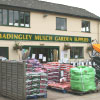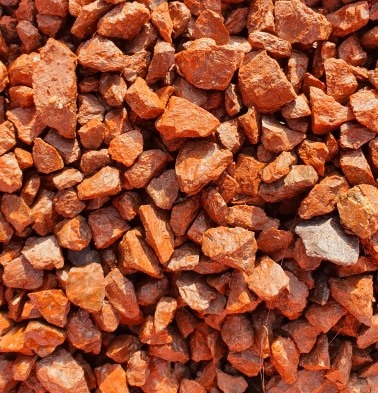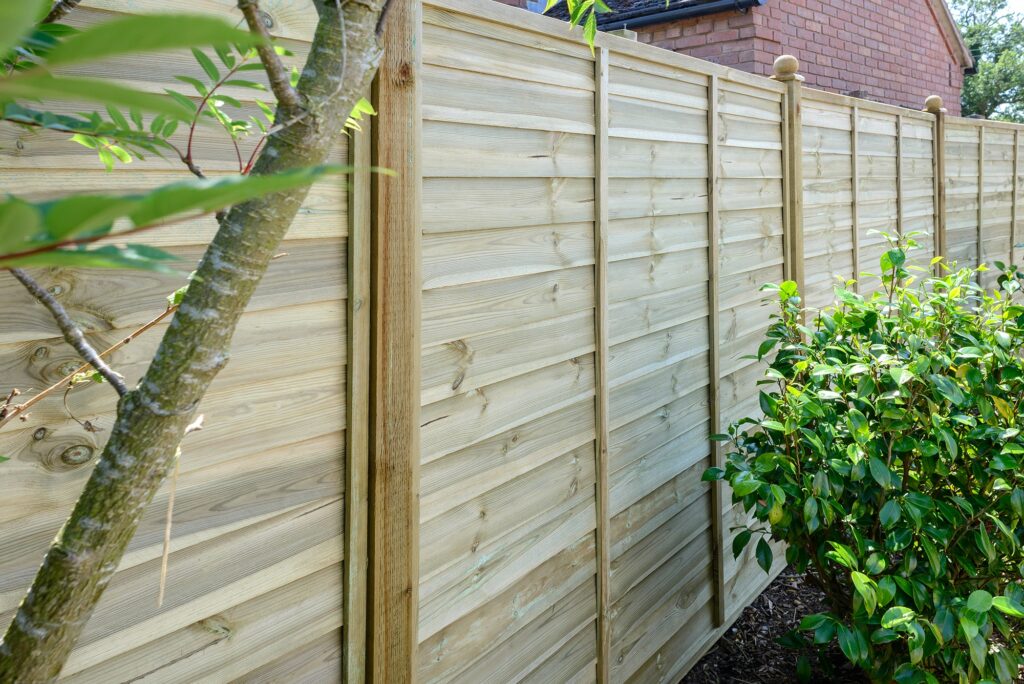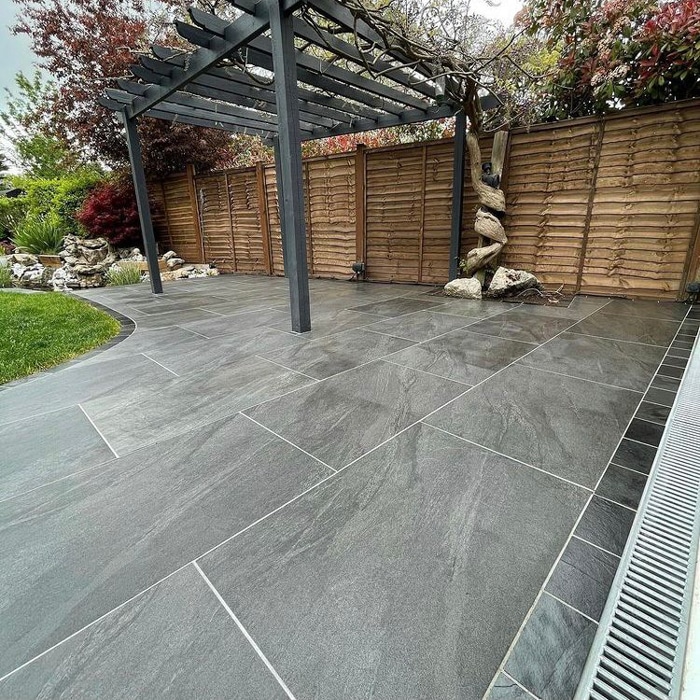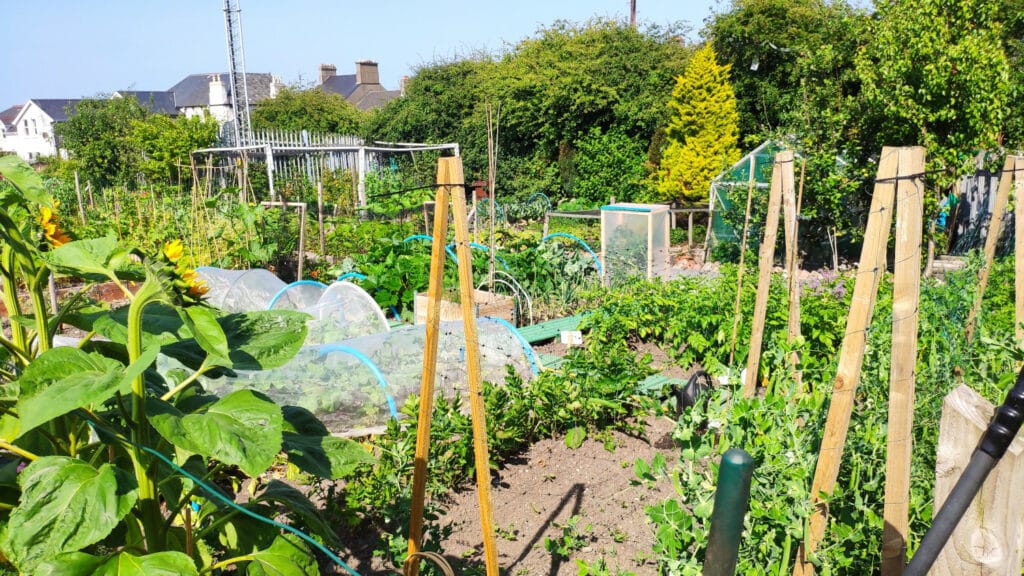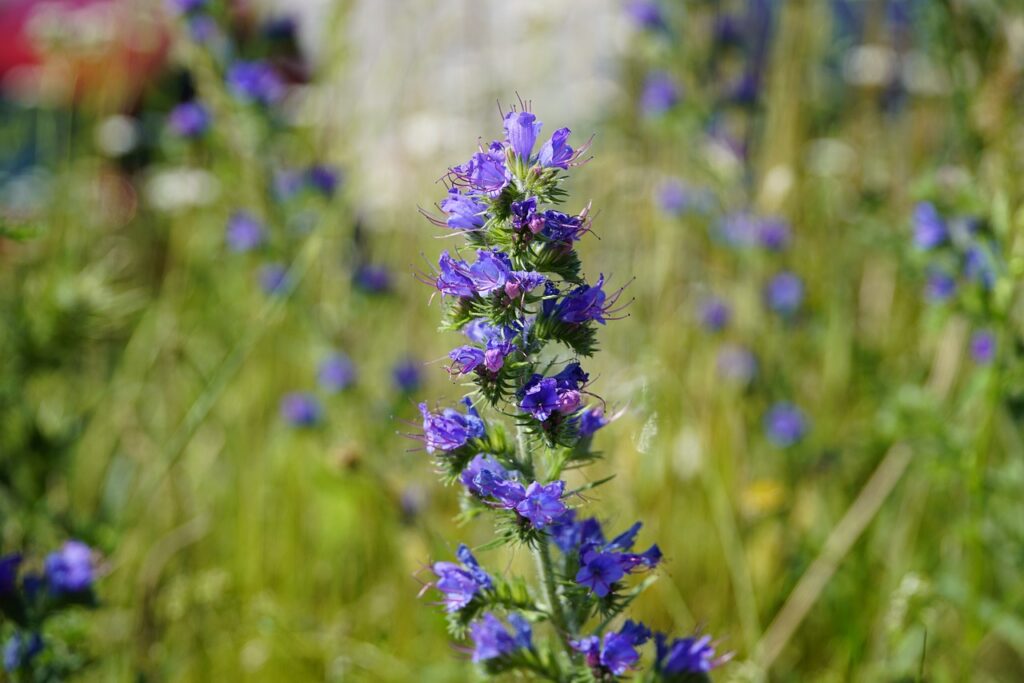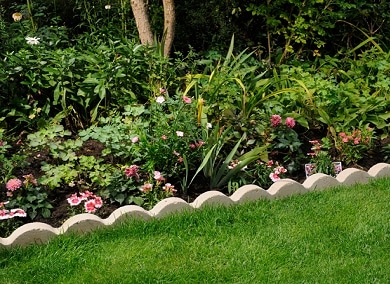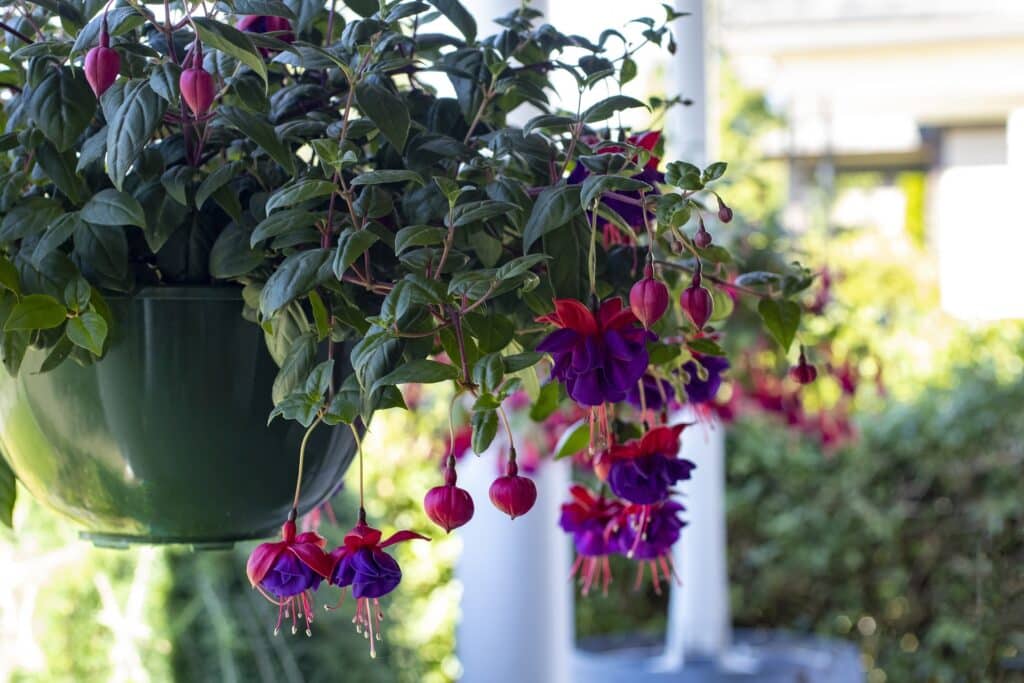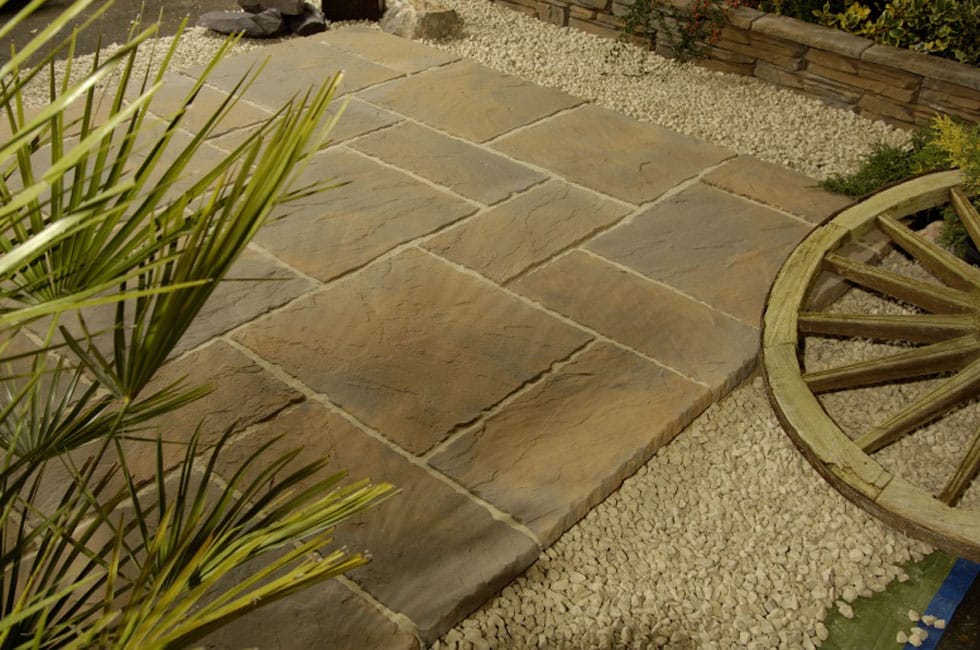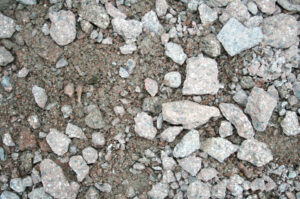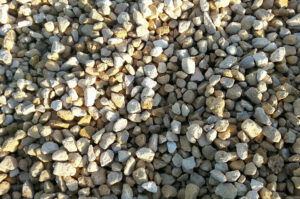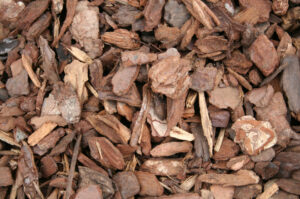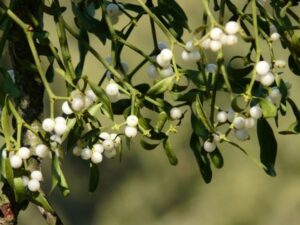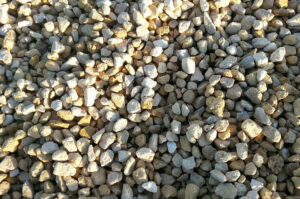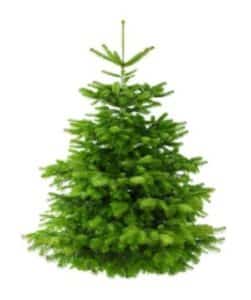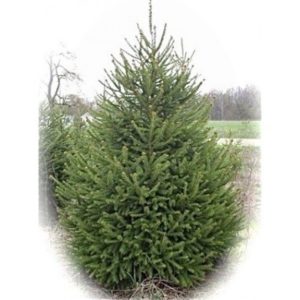Why Granite Chippings are Ideal for Your Garden
Madingley Mulch has just extended its range of granite chippings which are now available from its base on the outskirts of Cambridge. Here we take a look at some of the key advantages this material offers, and why we are your best port of call if you want to use it for a hard landscaping feature in your garden.
They are Very Hard
Granite is one of the hardest rocks around, having been formed by volcanic activity. It consists of a mix of minerals, including quartz and feldspar, and because these are mixed together (and not in separate layers like some other rocks) it is intrinsically harder. This means that the chippings won’t weather much wherever you put them, making them the perfect long-term investment.
They Can Act as Mulches
Non bio-degradable mulches (that is, those which aren’t made out of organic material such as bark or wood chippings) won’t boost the fertility or structure of the soil. However, using granite does have some benefits.
Firstly, it won’t damage any plants in your flower beds because the chippings simply sit on top of the existing soil. Secondly, it will suppress weeds and conserve moisture in your flower beds, in part thanks to their heavy weight. Lastly, granite chipping will help drain the soil, preventing it from becoming overwatered or puddles developing during heavy rain.
They Can be Used as Water Features…
Some natural stones, particularly those containing lime, can alter the pH balance of your pond water which is potentially dangerous to fish. However, this isn’t the case with granite chippings so you can use them in any kind of water feature. And some of them, for example, our 14mm red granite (pictured above) will deepen in colour when wet, making it really stand out.
…and They Have Other Uses Too
You don’t need to use them just as mulches or in water features. Granite chippings can also be used as driveways and pathways. They add a striking decorative touch, and are also a good security measure because you will hear the crunch underfoot as someone walks on it.
They Can be Bright and Colourful
Granite doesn’t need to all be one colour. As well as our red granite, which is also available in a 20mm size, we have a range of other colours, including green and our greyish-blue 14-16mm Berwyn Green. These can be mixed and matched in any part of your garden, which can create some striking effects.
Bear in mind that the climatic conditions in your garden should influence your choice, particularly if you are using it as a mulch. The Royal Horticultural Society points out that dark-coloured materials will warm the soil in the sun, whereas light-coloured mulch will reflect sunlight and keep roots cooler in strong sunlight.
Granite Chippings in Cambridge from Madingley Mulch
As well as granite chippings, we also stock a range of other decorative stone chippings for customers across Hertfordshire, Essex, Suffolk and our home county of Cambridgeshire. These include gravel, flamingo and our special multi-mix. For a full list, follow this link.
You can either order online as we have regular deliveries to Suffolk, Essex, Bedfordshire, Hertfordshire and Essex as well as closer to home in Cambridgeshire. Alternatively, you can visit us in person at our base on the edge of Cambridge. For more details on our delivery service, and how we calculate the charges, visit our deliveries page.
If you have any questions or need advice, feel free to call us on 01954 212144.
Why 6ft and 3ft Fence Panels are the Most Popular Sizes
Garden fencing can come in all shapes and styles – lap panels, overboards and picket fences to name just a few – and these fencing varieties can be topped off with trellises or supported by gravel boards.
However, there are two sizes which are the most popular – 3ft and 6ft fence panels, both of which we can supply from our base on the edge of Cambridge. Here we explain why these two sizes of fence panels are the ‘go-to’ products for most garden improvement projects.
The 6ft High Panel
Six feet roughly equates to 1.8metres in metric terms, and there are a number of reasons why fence panels are often manufactured at this height. One is the UK’s planning laws, which specify that you may need planning permission for anything over 2m tall which is not adjacent to a road or highway.
Something that is 1.8m tall is comfortably under this limit and will also give you the opportunity to add a gravelboard underneath. These can protect the base of the panel from damp soil, will help avoid rotting and dampness, and will prolong the lifespan of your panels.
There’s also the privacy angle – most adults aren’t much taller than 6ft (and certainly children aren’t), so it will protect your garden and property from any prying eyes and give you a bit more security.
At Madingley Mulch, we supply gravelboards and Superior 6ft fence panels. This style of panel is also available in 3ft heights, so you could add a trellis on top. However, to conform to planning regulations, you need to make sure the height of the two combined is still under 2m. Whichever height you opt for, our panels will give you a neutral backdrop for whatever plants you want to put in your beds (or in your lawn) and a clearly defined boundary.
The 3ft High Panel
3ft high panels, which we also stock at our base near Cambridge, are very popular for front gardens in particular. Again, there are planning reasons for this height – you aren’t allowed to put up a fence which is more than a metre high if it’s adjacent to a highway or road used by vehicles.
Lower fence panel heights are ideal for marking out where a property starts and ends for demarcation purposes, and don’t present much of an obstacle if you want to climb over them. You may also want to see out of your front window to see what’s going on in the street or keep an eye out for any deliveries.
Often, 3ft high panels in front gardens are picket fences, as these are more picturesque than a lap or overboard panel and look more ‘open’ and attractive from the street. At Madingley Mulch, we supply 1.8m x 0.9m picket fence panels (the 0.9m roughly equates to 3ft) – for more details follow this link.
Whose Responsibility Are They?
If the new fence is going up between you and your neighbour’s home, and you are worried about the legal position, then the best course of action is to check your property deeds. If there’s a ‘T’ on one side of the boundary and it’s on your side, then you can put a new fence up – but equally you are responsible for maintaining it too. If the T is on the other side, then it’s down to your neighbour.
If there’s an H on the deeds – effectively a T with an extra stroke – then it’s a shared responsibility; so talk to your neighbour about it if you haven’t already.
Other Fencing Products from Madingley Mulch
As well as picket and lap panel fencing, trellises and overboards, we also supply a number of other accessories if you are planning a fencing project. If you visit our online shop you can see we stock fence posts and fence post mix so you can be sure that your panels are securely anchored. You can either buy these in person from our site on the outskirts of Cambridge or you can have them delivered to your home address, provided the order comes to at least £50.
We recently changed our delivery policy to reflect our increased costs – it’s now £2 per-delivery unit if you live between 0-5 miles from our base, up to £16 if you live between 30-40 miles away. More details are available on our delivery page.
The Advantages of Porcelain Paving
Madingley Mulch is now stocking porcelain paving at its Cambridgeshire base, both in-store and online. Here we look at how this product is made, the advantages it offers, and how we can meet all your needs if you want to give your garden pathways and patios a new look.
How is Porcelain Paving Made?
Porcelain paving is made by baking clay, sand and other minerals; usually these include feldspar, a granite-like material. All of them are mixed in specific quantities with cold water into a slurry. This is then dried, stored and pressed or compacted together before being ‘baked’ in a high-temperature kiln (it can be as hot as 1,200 degrees Celsius). The porcelain is then allowed to cool, cut into a size, and given a protective coating before going on sale.
So what advantages do porcelain paving slabs have?
They are Very Hard-Wearing
Porcelain paving slabs won’t discolour, and they are highly resistant to scuffs and scratches. They also are far less porous than many other materials, which means water won’t build up inside the tiles, meaning that frost won’t be a problem either. (Porcelain paving slabs can’t be described as completely waterproof, but they are highly water-resistant).
This means they will retain their original finish for a long period of time – even in areas with a high footfall, such as garden paths.
They are Very Low-Maintenance
Because of its high levels of water resistance, porcelain paving won’t need much ongoing care. As well as avoiding the problem of frost, you won’t get any moss, algae or unwanted plants taking hold in the slabs. This will cut down on the amount of cleaning and power-spraying they will require in the years ahead.
They Can be Highly Slip-Resistant
You are also less likely to slip, trip or fall on a porcelain tile if it’s been raining. This is partly because algae is less likely to grow on them, and partly because it’s very easy to apply a slip-resistant finish to them.
This is particularly useful even if you are using them as part of a covered patio. Ice, snow and rain won’t be a problem, but if you are using the patio as an extended outdoor dining area someone, at some stage, is bound to spill a drink – no matter how many precautions you take. The increased slip-resistance is also useful if you are using the tiles to surround a swimming pool; you don’t want to trip and fall into the water.
They are Perfectly Symmetrical
Because they are produced in a factory, to a set specification, every tile should be the same when it comes to colour, quality, size and texture. This will help give your garden a more orderly appearance and a more formal look. It could also provide a stylish extension from your kitchen area into your outdoor space.
Porcelain Paving in Cambridgeshire from Madingley Mulch
At Madingley Mulch, we are now stocking the Avant Garde collection of porcelain paving. This comes in a wide variety of shades and designs – namely Cathedral Anthracite, Himalayan White, Kandla Porcelain, Mercury Grey, and Quartz Light Grey and White. All of them are perfect for patios, pathways, pool areas and terraces.
They come in 21.60m2 packs, although individually packed tiles can be collected from our base on the outskirts of Cambridge. For more information about the whole collection, follow this link.
If you prefer to stock more traditional textured or natural paving, then we are still stocking plenty of varieties – including Old Grey Courtyard Paving, Indian Sandstone and Rutland Oakham slabs. For more details click here.
Given the weight of the paving – whichever type you order – you may like to take advantage of our delivery service – we can deliver all our building and outdoor gardening supplies in Cambridge, across East Anglia and further afield. We are now operating these on a sliding scale – so the closer you are to us, the cheaper it will be. For more details, check out our delivery page here. You can also call us on 01954 212144 if you have any questions.
Using Madingley Mulch for Your Allotment Supplies
Allotments have really come of age in the last few years – and it’s not just because next month marks the 21st anniversary of the first National Allotments Week here in the UK. The rising cost of living has encouraged more people to grow their own when it comes to fruit and vegetables – and the plots have proved remarkably good therapy for people who might otherwise have been stuck in their homes during coronavirus lockdowns and periods of isolation.
To help assist budding fruit and vegetable growers, Madingley Mulch offer garden allotment supplies to customers in Suffolk, Essex, our home county of Cambridgeshire and across East Anglia. Here we look at the history of the allotment, and how the large variety of products we have in stock mean we can help ensure you get the most out of your plot.
The History of the Allotment
Allotments have their roots in Anglo-Saxon times, when huge fields belonging to the village or manor were given over to residents to grow their own fruit and vegetables. This was known as the open-field system; sometimes woodland would be cleared for this purpose and the land would be designated common land. However, after the Norman Conquest much of the land ended up in the hands of manorial lords and the Church.
It wasn’t until the General Enclosure Acts of the 1830s and 1840s, and the Small Holding Allotments Act of the early 20th Century, which brought the need for allotments back into focus. The various Acts meant that local authorities had a duty to provide them to residents, assuming that the local population could prove there was a demand. The lack of any Welfare State, and the two World Wars, highlighted the need for all nations to ‘Grow their Own’ and be more self-reliant when it came to their own food supply.
Allotments Today
Although there was a dip in the number of allotment-holders after the Second World War, they are now more popular than ever. The BBC TV comedy programme The Good Life, about a 1970s couple who forsook the ‘rat-race’ to become self-sufficient, increased interest in allotments.
In more recent years, a growing awareness of carbon footprints and the need to be more sustainable – as well as the rising cost of living – has seen sustained growth in the number of plot-holders. There are now around 330,000 people across the UK who rent out an allotment today.
Most of these allotments are owned by local councils, who charge an annual fee for their use (this varies from region to region). Many still have long waiting lists if you would like a plot of your own. Most plots are measured in rods (perches or poles), which dates back to Anglo-Saxon times. Ten poles is the generally accepted size of an allotment – the equivalent of 250 square metres or about the size of a doubles tennis court.
Allotment Supplies in Suffolk and Across East Anglia from Madingley Mulch
This year, the main theme of National Allotment Week is Soil Health – which is important for gardeners who want to get the most out of their plot. At Madingley Mulch, we stock a range of composts, mulches and soil conditioners from our base on the outskirts of Cambridge – including exclusive products such as ‘Denise’s Delight’ and ‘Tony’s Tonic’. All our soil improvers will help suppress weeds, help the ground retain moisture and promote the growth of your fruit and vegetables.
We also stock a number of weed-suppressing membranes and fixings to give your crops extra protection. There are also a number of high-quality garden tools in our online shop to help you with your digging, hoeing and any other tasks that need doing on your plot. You can also give us a call on 01954 212144 if you need any help or advice.
If you have a particularly large order, remember we offer a weekly delivery service in and around Cambridgeshire – see here for more details about our pricing structure.
- National Allotment Week is running from August 7-13, and there are a number of events around the country.
Top Trends from the RHS Chelsea Flower Show
One of the major events in the horticultural calendar took place in London at the end of last month – the Royal Horticultural Society Chelsea Flower Show. It’s the place to go to see innovative, cutting-edge garden design, as well as new plants. Here Madingley Mulch, who supply soil conditioners and mulches from our base on the edge of Cambridge, take a look at some of the key trends from the show.
Accessibility
The 2023 Chelsea Flower show recognised the fact that gardens are havens where people go to relax, particularly if they have a physical or mental disability.
The Best Show Garden was Horatio’s Garden, designed by Charlotte Harris and Hugo Bugg. It was a wheelchair-accessible garden that has been designed for patients recovering from spinal injuries and will be relocated to the grounds of the Northern General Hospital in Sheffield. Its key features included plenty of trees, such as river birch and field maples, as well as several herbaceous plants and grasses.
The Best Show Garden (People’s Choice) was Myeloma UK’s A Life Worth Living Garden, designed by Chris Beardshaw. This garden included a pathway between temples and a water feature, layered canopies of trees and shrubs (including acers), and delicate blooms provided by aquilegas, geraniums and symphytum. Again the idea was that anyone suffering from myeloma (a rare form of blood cancer) could find somewhere to relax and contemplate the beauty of nature.
The National Brain Appeal’s Rare Space Garden won Best Sanctuary Garden and the accompanying construction award. The idea here was to create an outdoor space that could be enjoyed by people living with rarer forms of dementia. The garden included blue benches and shelters, a single pathway through it, and plenty of brightly coloured plants including parrotia persica (a deciduous shrub), astrantia burgundy manor (with deep red flowers), and chloranthus sessilifolius ‘Domino’, which has scented fluffy white flowers.
Sustainability
This year there was a far greater focus on letting nature take control, with more native plants and trees. Many of the gardens themselves will be reused and repurposed so they will ‘live on’ long after the show is over. For instance, The Best Show Garden will be transplanted to the grounds of the Northern General Hospital in Sheffield, for patients and staff to enjoy.
Parts of the A Life Worth Living garden will be reused and repurposed in two different Scottish locations, The Hurlet Crematorium in East Renfrewshire and the Beatson Cancer Centre in Glasgow.
Biodiversity
Another of the key themes was biodiversity, and particularly the rich variety of wildlife (including insects) you can find even in the least promising environments.
The Royal Entomological Society Garden (designed by Tom Massey) showed how plants (and insects) can survive and thrive even in dead wood, bare sand, piles of rubble, and rammed earth floors. Colours were provided by pink poppies (Beth’s poppy) and electric blue Echiums (pictured above). Again, the garden will be reused at the centre of business development in Stratford, East London.
The Samaritan’s Listening Garden (which won a Silver-Gilt Medal) uses material reclaimed from building sites and scrapyards, such as concrete boulders and benches. The garden contained a water feature, intentionally-planted dandelions and other ‘weeds’, spiky plants as well as some ‘softer’ species’.
Soil Conditioners in Cambridge from Madingley Mulch
Whatever affects you want to achieve in your garden, whether inspired by the Chelsea Flower Show or not, Madingley Mulch will be able to help. We supply a wide variety of mulches, barks, soil conditioners and composts to help your plants thrive, whether they are echiums, poppies or acers.
Our exclusive soil improvers include Tony’s Tonic and Denise’s Delight, a natural soil conditioner with an exclusive mix of Black Fen soil, horse manure, wood shavings and other plant nutrients.
We also stock a variety of hard landscaping materials. These include building sand and ballast, plus a selection of gravels, round stones, shingle, decorative stones and pebbles.
For more information check out our online shop here. You can also call us on 01954 212144 with your queries.
Why Should You Install Garden Edging Stones?
If you want to give your garden a real edge – literally as well as metaphorically – then you should install some special stones that will help define your garden in more ways than one. Here Madingley Mulch, who provide edging stones from their base just outside Cambridge, provide four advantages of using them for gardeners.
- They Keep Unwanted Weeds (and Human Visitors) Away
Good quality edging stones will stop invasive grasses and weeds from growing into your flower beds. This means the plants you want to encourage will get all the nutrition they need from the soil without having to compete with other plants for it. They don’t have to just be used on flower beds either – vegetable patches can be protected in a similar way.
Edging stones have the added benefit of deterring animals (particularly burrowing creatures) from damaging your beds. Clearly-defined edging can also define walkways and pathways, meaning people are more likely to go only into areas of your garden where you want them to.
- They Keep Soil Improvers (and Stones) In
Edging stones don’t just keep unwanted invaders out, they ensure that soil treatments don’t spill out into other areas as well. For instance, bark chip mulch, when it is laid down, can easily spill over onto lawns and paths if it’s been particularly wet or windy.
It’s also much easier to water, and spread fertiliser, in areas with edging as it’s much easier to see what you are doing and where it is going. And, if you have gravel in your driveway or flower beds, lining either of them with edging stones will ensure small pebbles don’t end up either on the grass or inside your home.
- For The Aesthetics
Edging stones also help with the overall appearance of your garden, providing clearly defined areas and a much ‘cleaner’ look. It doesn’t have to be put down in straight lines either; a gentle sweeping curve can be just as effective. In the case of patios, edging stones can emphasize the lines of the flower beds and lead the eye to the next focal point in the garden.
If edging is laid, particularly in your front garden, it can boost the value of your property should you ever decide to put it on the market – what estate agents call ‘kerb appeal’ which will help your property stand out from your neighbours’. Our decorative garden edging is available for customers in Bedfordshire, Hertfordshire and Essex, as well as our home county of Cambridgeshire.
- They Help with Garden Maintenance
Having clearly defined edges should make some of the more mundane gardening tasks easier too. For example, mowing grass is a much simpler matter if it isn’t growing all over the place. The edging stones also provide a natural barrier so you can’t physically mow your plants either. Weeding is also much less of a problem if the unwanted plants can be confined to certain areas.
Edging Stones in Cambridge from Madingley Mulch
We supply 600mm long decorative stones for garden edging along pathways, drives or garden borders to customers in Suffolk, Cambridgeshire, Essex, Hertfordshire and Bedfordshire. We also supply other decorative stones and paving slabs so all of your hardscaping needs can be met at Madingley Mulch.
If you have a large order, then we offer a weekly delivery service to many towns and villages in the region. Delivery is now charged on a sliding scale to take into account the distance travelled. For full details, follow this link.
If you have any questions, you can always call us directly on 01954 212144.
Six Top Tips for Planting Your Hanging Baskets
Now is the time of year when many gardeners start thinking about hanging baskets because the risk of frost has largely passed. They make a picturesque and convenient addition to any outdoor space, no matter how big or small.
Here Madingley Mulch, who supply Black Fen soil garden products to customers in Suffolk, Essex and our home county of Cambridgeshire, provide six top tips on how to make the most of your hanging baskets.
- Use Fen Soil Topsoil
Beginning at the bottom, you should always use a top-quality compost or soil improver on top of your basket liner (whatever this is made of), as any plants grown in confined spaces need the best possible start.
Our best-selling topsoil, which is only available in the Cambridgeshire area, is a screened soil, which means it has been well filtered removing the larger clods of earth along with any stray plant roots and stones. It’s also peat-based which makes it ideal for use in hanging baskets.
- Think Structure
You should always start off with a sturdy central plant in the middle of the basket to give others something to work around. Begonias make for the ideal centre point for any basket, thanks to their large and colourful single or double flowers. Trailing plants such as fuchsias are better left to the outside of the basket to give them maximum space to grow, as can be seen in the picture above.
- Think Colour
Unless you have a fetish for a particular shade, or want to plant more than one basket at a time, it’s always a good idea to have different colours. Pansies, petunias and geraniums are always a good choice, not just because they flower reliably, but because they have a number of different coloured varieties.
- Think Water
In the height of summer, particularly if it’s another warm one like this year, you will need to water your basket once a day. Don’t worry too much about overwatering as any excess should drain out of the bottom of the basket. It’s also worth ‘topping this up’ with a weekly feed of liquid fertiliser to ensure the flowers get all the nutrients they need.
- Prepare to Prune
It might seem unusual to prune your hanging basket, but it makes sound growing sense. Cutting off the first flowers, as well as pinching shoot tips, will ensure stronger roots and better growth later in the season, meaning your basket will look better for longer. In fact, it’s worth deadheading and trimming any plants if they start to look a worse for wear at any time, and not just at the beginning of the season.
- Recycle It at the End of the Season
At the end of the growing season, your hanging basket can still have a role to play. Tip the contents onto the compost heap (if you have one). And, according to the Royal Horticultural Society, some hardy plants (such as ivies) could be replanted into your main garden.
Black Fen Soil in Suffolk from Madingley Mulch
Black Fen soil isn’t just for use in your topsoil, it’s also a core ingredient of Denise’s Delight, a soil improver available exclusively from our base near Cambridge and which is ideal for use in raised beds. It also contains well-rotted horse manure, humus and other plant nutrients.
If you’d like to buy your fen soil or any other garden or DIY products from us, you can order them directly from our online shop. We also deliver to addresses in Cambridgeshire, Suffolk, Essex and further afield.
If you have any garden-related queries, follow this link and fill in the online form.
Key Uses for Sand in Your Garden
Sand isn’t just something that you find on beaches, it can be an essential tool for improving your garden. Here Madingley Mulch, who supply bags of sand to customers in Essex, Suffolk and our home county of Cambridgeshire, outline some of its most important horticultural uses.
For a Play Area
Your children can use a special mixture in their play area or sand pit. This sand tends to be much finer with fewer large items than regular ‘building’ sand.
The benefits of having a sandpit are well-known for children’s physical and mental health. It keeps them active, improves their hand-eye co-ordination, and shouldn’t get them too dirty. At Madingley Mulch, we supply children’s play sand which is free of stones and doesn’t stain.
Warning – don’t be tempted to spread children’s play sand on your plants, as this could harm them. This is because it is a different mixture to regular sand that usually has a higher salt content.
As a Building Base
Sand is a good base if you are laying paving stones or patio slabs. The reason is that it can hold just as firmly as cement, while still draining well, meaning that rain can easily escape through the slabs and into the soil.
It can also be used for screeding, a method of constructing a well-profiled bedding layer where flags or bricks or any other regular thickness paving slabs can be directly laid onto it with no need for any further levelling. It can also help if you need to render your garden wall.
At Madingley Mulch, we supply sharp sand, which is also known as building sand, which is ideal for bedding paving stones and patio slabs, as well as for external and floor screeding and external rendering. We also stock soft sand, which is great for mixing mortar to lay stone slabs or bricks. In addition, you can buy paving slabs from Madingley too.
As a Lawn Improver
Sprinkling some sharp or building sand over your lawn can work wonders for the grass, particularly if it’s already in poor condition. This is because it kills and prevents moss, and also improves drainage and air circulation.
This sand works particularly well on heavy clay soils such as those found in East Anglia, where the density of the soil means it can be difficult for the grass roots to grow healthily unless some sand is added. For more information on soil types, check out our previous blog here.
Don’t just sprinkle the sand onto the grass its own, as it is more effective when used as part of a wider lawn top dressing mix that also contains soil, peat and loam – and which we also supply at our site on the outskirts of Cambridge. You can also use sand underneath your lawn as part of a soil/sand mix, which is a good base for either turf or grass seed.
In both cases, results won’t be instant, but you should notice a marked improvement in the quality of your grass over time.
Bags of Sand in Essex from Madingley Mulch
If you have any questions about which type of sand is best for your garden project, give us a call on 01954 212144 and we’ll be happy to help.
We can supply your order to you in bulk bags, small bags or weighbridge collection. The minimum order for delivery is now £50. We have also introduced a new sliding scale based on the delivery distance, full details of which can be found on our delivery page. But don’t worry, we are still delivering to all the destinations we used to, including St Ives, St Neots, Newmarket, Royston and further afield.
And don’t forget to check out our offers section because we have some great seasonal bargains.
Which Garden Design is Best – Straight or Curved?
The average UK garden is 188 square metres in size, according to the website Garden Patch. While the actual size may vary depending on where you live, the likelihood is that it will be either square or rectangular. However, do you need to stick to such a regimented shape when it comes to your garden design?
Madingley Mulch provide paving slabs to customers in Bedfordshire, Hertfordshire, Essex and our home county of Cambridgeshire. Here we look at the advantages offered by both straight lines and curves (particularly when it comes to patios), and how we can help with your garden landscaping needs, whatever design you end up choosing.
Championing Curves
One way of making sure you don’t end up with too regimented a shape is to ensure curves are an integral feature of the garden. This is because they can create an illusion of space, making the garden appear bigger than it really is and also less exposed. Curves also add an air of mystery to a garden, such as a winding path around a corner that poses the question – where does it go?
How to Achieve It
If you are digging out a bed, border or patio, use a piece of hose laid in the desired shape as a guide before getting the spade out.
In planting terms, avoid shrubs that are likely to grow more vigorously outwards, as these could lose the definition achieved, and make a small space feel even smaller. Also, landscape designers tend to add kidney or teardrop shapes to lawns to break up the natural block effect if they are left completely square. Edging stones will help add greater definition between paved and planted areas too.
It Can Still be Hip to be Square
Using straight lines can still be the simplest and most cost-effective way of gardening. This is because you can stick to the natural contours and shapes of your garden, saving the need to spend so long digging things out. It will also give you a classic design that is both contemporary and timeless. And remember, you can add extra interest by making your garden tiered or split-level, or by using raised beds.
How to Keep Everything Straightforward
If you are digging out a lawn or flower bed, use string or twine stretched between two points to ensure you keep to a straight line. The same applies to patios, although you don’t need to have one mass block of slabs. You can leave spaces for pots and planters; and our Indian sandstone paving slabs, which we supply to customers in Suffolk, Essex, Herts, Bedfordshire and Cambridgeshire, also come in a choice of four different colours.
You can also create separate zones, such as a children’s play area, or an area where the garden can grow wild. You can garden upwards as well with the help of trailing plants that grow up or through trellises and fences.
It Needn’t Be One of the Other
You can also mix the two styles, for instance, square and round beds provide an interesting contrast. The formality of square or rectangular beds can be offset by putting soft, billowing plants such as ornamental grasses in them. Additionally, you shouldn’t overdo the curves either, as adding lots of small curves to a border or bed can ruin the overall effect and be more time-consuming to dig out. Ideally, you need a smooth, uninterrupted curve.
Paving Slabs in Bedfordshire with Madingley Mulch
Regardless of whether you opt for a curved or square garden design, at Madingley Mulch, we will be happy to help you. You can call us on 01954 212144 or pop into our store on the edge of Cambridge to ask for advice and buy the supplies you need.
If you have a big order for paving slabs, either for a pathway or patio, we can deliver them straight to your door (minimum order £50). We have also introduced a new sliding scale for delivery charges. It’s £2 if the delivery address is up to five miles away from our base, up to £16 if the address is 30-40 miles away. We can also deliver further afield as well. For more information on our delivery charges, follow this link.
MOT Stone Types Explained
For most people, if they hear the phrase ‘MOT’, they think about the annual test your car has to pass in order to stay on the road. However, although the abbreviation may effectively be the same, it means something very different when it comes to stones and aggregates. Madingley Mulch provide Type 1 stone and hardcore to customers in Cambridge and further afield. Here we explain the finer (and coarser) points of the various stone gradings.
The MOT Part
As with cars, the MOT stands for Ministry of Transport (nowadays it’s known as the Department of Transport). Sometimes the MOT is omitted where it is clear that you are talking about stones and aggregates.
The reason it has the MOT prefix is because the stone has to adhere to certain standards for use on the roads (for example, the DOT’s specification for highway works). Type 1, in particular, is used in roads, pavements, car parks and other public areas, so it’s essential that it meets certain minimum safety standards.
Type 1, 2 or 3?
There are three types of MOT stones and aggregates:
Type 1 is a crushed aggregate often produced using materials such as limestone, gritstone, basalt, brick, concrete and hardcore. As well as its use in roads, pavements, car parks and other public areas, it can also be used in a variety of garden projects including sub-bases for patios, driveways and paths. It is usually between 0-40mm thick and is sometimes referred to as ‘hardcore’.
Type 2 is usually finer than Type 1 (being between 0-20mm thick) and is particularly suitable for driveways, pathways and walkways. This is because the size helps it to drain particularly well.
Type 3 is a coarser, more granular material (between 5mm and 40mm thick). It is typically used in road construction and as a base layer for other materials such as asphalt.
Type 1 Stone in Cambridge from Madingley Mulch
At Madingley Mulch, we supply MOT Type 1 (pictured above) in quantities of either 25kg or 800kg. And, as one of the leading aggregate suppliers in Cambridge, we also stock 20mm and 50mm limestone. The former consists of limestone chippings ranging in size from 20mm down to dust, which can be used as a final top layer for hardcores, while the latter is ideal for larger drainage projects.
For a complete list of all our aggregates we currently have in stock, follow this link.
Other Hardscaping Projects
At Madingley Mulch, we can help not just with the sub-bases for patios and driveways, but the materials to go on top of them as well. To check out our full selection of gravel (for paths and drives) and paving slabs and their prices, click here.
At the moment, delivery is between two and seven days from the time of your order. Following a period of severe inflationary pressure, we have now revised our arrangements to more accurately reflect the cost of delivering your order in what is the first change for more than two decades.
From the beginning of this month we are charging £2 per delivery unit for deliveries between 0-5 miles from our base near Cambridge; there is then a sliding scale of charges which increases the further away we have to deliver. (For deliveries between 5-10 miles away, the charge is £4; between 10-20 miles, it’s £8; between 20-30 miles it’s £12; and between 30-40 miles it will be £16). If the delivery address is more than 40 miles away then call us on 01954 212144 for an individual quote.
For the full list of revised charges, including the new minimum order levels, follow this link.
Why is Cotswold Stone so Good for Gardens?
One of the most popular types of decorative stone used in gardens across the UK is Cotswold gravel. Madingley Mulch supply Cotswold gravel to gardeners in Hertfordshire, Essex, Suffolk, and our home county of Cambridgeshire. Here we explain some of the reasons behind its popularity.
It’s Easy to Work With
Cotswold stone is a type of limestone that was formed when the area now known as the Cotswolds was covered by a warm sea. Layer after layer of shell fragments and skeletal remains of marine organisms built up on the seafloor, over time creating large beds of limestone across the area. Similar conditions can be found today in Florida and the Caribbean Sea.
Because Cotswold stone is porous due to its exposure to water, it is also easy to carve or break into smaller pieces such as chips or pebbles.
It’s Decorative
Another strong point of Cotswold stone is its colour. As the stone weathers its outward appearance can vary from golden, honey or pearl. This is down to the stone’s original composition, which varies depending on which part of the Cotswolds it comes from.
It is honey-coloured in the north, golden in the central Cotswolds and progressing to a pearly white in Bath in the south of the region. This means you have a choice of colours or can mix and match – whatever combination you opt for, it makes a decorative addition to your garden.
Cotswold stone does better if you pair it with plants that thrive in alkaline conditions (the limestone itself is alkaline). So campanula, clematis, lavender and geraniums will all thrive in a Cotswold gravel bed. It may be more difficult for plants such as rhododendrons, heathers, azaleas and hydrangeas to do well if in close contact with Cotswold stone because they do better in acidic conditions.
It’s Functional
Cotswold stone, because of its porosity, drains well, so it is a functional alternative to compost when it comes to your flower beds. It also acts as a good mulch because of its ability to suppress weeds and is particularly good in winter as it offers protection against frosts.
It can be laid to level out any uneven areas in your garden too, which helps if you have any children or pets. It’s good for security as well because you can lay it down on paths making it possible to hear any unwanted guests in your garden.
It’s Weather Resistant
It’s also used as a building material in houses and in dry stone walls, particularly in the Cotswolds. The fact that it has the ability to absorb and release water makes it more suitable, not less. This is because all walls need to have this ability otherwise there will be a build-up of moisture over time, weakening the overall structure.
At a smaller level, Cotswold gravel, due to its angular shape, will always lay flat. This helps to create an interlocking surface that will be solid and secure when used on a path or driveway. It’s also extremely hard-wearing and low-maintenance. The occasional wash-down with a hose during dry spells should be more than enough.
Cotswold Gravel in Hertfordshire from Madingley Mulch
We supply different types of Cotswold gravel to customers in Hertfordshire, Suffolk, Essex, Bedfordshire and Cambridgeshire. We stock Cotswold buff (the buff refers to the light brown/yellowish colour) as well as larger garden chips.
If you’d prefer something more organic to use as mulch, then we stock a range of soil conditioners at our base near Cambridge, including our exclusive products, Tony’s Tonic and Denise’s Delight.
We have now changed our delivery arrangements for the first time since 1999. The minimum order eligible for a delivery has increased from £40 to £50; and we have now introduced a sliding tariff of charges to reflect the cost of getting your order delivered (and the space it takes up on the lorry).
For instance, if your delivery address is between 0-5 miles from our base near Cambridge, then we will be charging £2 per delivery unit; for 5-10 miles, the charge is £4; between 10-20 miles, it’s £8; between 20-30 miles it’s £12; and between 30-40 miles it will be £16. If the delivery address is further than 40 miles away then call us on 01954 212144 for a tailored quotation.
We are defining a delivery unit as either a single bulk (½ or 1 cu m) bag or pack of paving slabs, or a group of other products (such as small bags of cement, tools, fencing products, etc) up to the value of £50 in total. More details about our revised delivery arrangements can be found here.
Top Tips on Alternatives to Peat-Based Compost
Amateur gardeners won’t be able to use any peat-based compost after 2024. Although it can help plants to flourish in poor growing conditions, the Government has decided that all domestic sales in the UK should be banned after that date.
Madingley Mulch are leading bark mulch suppliers in Hertfordshire, Essex, Suffolk and our home county of Cambridgeshire. Here we examine the reasons for the decision, and why many of our products are ideal if you want to switch to a different soil improver ahead of the ban.
The Reasons for the Ban
Peat is partially decomposed plant material and is one of the planet’s most effective storers of carbon. Whenever it is extracted from its natural habitat – most of the UK’s peatlands are in Scotland – then the carbon is released. This combines with oxygen in the atmosphere and is released as carbon dioxide.
The Government wants the UK to be ‘net zero’ when it comes to carbon emissions by the year 2050. Given that bagged compost accounts for 70% of all peat-based product sales in the UK, it was a natural target for a ban.
Peat extraction also damages the natural habitats of several different species (less than 15% of the UK’s peatlands are still in a natural or near-natural state). Hen harriers, skylarks, red grouse, meadow pipits and many other birds are all native to peatlands; in all cases their numbers are in decline. Extraction also negatively impacts the peat’s ability to prevent flooding and filter water.
Environment Minister Richard Benyon said, when announcing the ban: “This Government understands the importance of keeping peat healthy and in the ground, here and around the world – to lock up carbon, strengthen drought resilience and serve as a powerful nature-based solution to climate change.”
“The actions announced today mark a new chapter in the story of our iconic peatlands – safeguarding their long-term health and vitality as part of our commitments to achieve Net Zero and deliver our 25-Year Environment Plan.”
Peat Substitutes
So, what can gardeners use instead of peat? Here are a few suggestions.
Compost – Many composts don’t contain any peat at all and can still effectively store and release nutrients and water. Alternatively, you can grow your own compost.
Mulches – These can be effective as weed suppressants and help plants retain moisture. We stock a range of mulches, including decorative mulch which can also be used in play areas as well as in flower beds.
Bark and Wood-Based Products – The Royal Horticultural Society (RHS) says that bark and wood products (as pictured above), such as chips and shavings, will also improve the soil without doing any damage to the environment; both are renewable materials. At Madingley Mulch, we stock a wide range of bark and woodchip products – for more details, click on this link.
Other Soil Conditioners and Improvers – Well-rotted animal manures are also a good way of improving soil, says the RHS. This is one of the key ingredients of Denise’s Delight, which is available exclusively from us. It also contains Fen soil, humus and other plant nutrients. It’s ideal for use in raised beds.
Tony’s Tonic, which is another of our exclusive products, also contains well-rotted horse manure. It can be spread over the soil or dug in and makes an excellent mulch, even in the winter months.
Madingley Mulch – Bark Mulch Suppliers in Hertfordshire
We don’t just stock soil improvers and conditioners – you can also buy tools, decorative stones and pebbles, paving slabs and many other garden products at our base on the outskirts of Cambridge. Our full range can be found here and can also be ordered online.
If you wish to place a large order, we offer a free delivery service within 15 miles of our nursery. A standard £20 delivery charge applies up to a radius of 25 miles, regardless of how many bags you order. If you need a delivery beyond this area, please call us on 01954 212144 for a quote.
Traditional Christmas Plants – and Top Tips on How to Grow Them
One of the integral parts of the forthcoming festive season are plants – indeed, it would be hard to imagine Christmas without the holly and the ivy, the tree and the mistletoe.
Madingley Mulch provide soil conditioners and composts from our base on the outskirts of Cambridge to gardeners across East Anglia. Here, we provide some top tips on growing and looking after your own festive plants.
Mistletoe
Although kissing someone under the mistletoe is a Christmas tradition, the reality of the plant is not quite so romantic – it is actually a parasitic plant which sinks its roots into, and gets its nutrition from, a host plant. Apple trees, hawthorns and poplars all make good hosts.
There are male and female mistletoe plants, and only the latter (pictured) carries berries. It can be grown from seed, although you will need to harvest the berries in March or April. To have the best chance of success, pick the berries from a tree which is the same species as your own intended host.
Insert the berries in any small crevice or gap which is fairly high up the tree, then provide some protective covering to prevent the birds eating them. Don’t be tempted to try and use berries which have been hanging in the house over Christmas as these have probably dried out. And remember, growing mistletoe is a long-term project – plants can take five or more years to reach berrying size, warns the Royal Horticultural Society.
Holly
This is another item which is essential to a traditional Christmas, with many people hanging holly wreaths on their front door; and, along with ivy, it has a carol named after it.
Holly has male and female flowers, and you’ll need both to produce a bush with berries. They need a moist soil with plenty of organic matter, and they grow in either full sun or part shade. They can be planted at most times of the year (ideally not in summer) in flower beds, patios or large pots.
Make sure you give them plenty of space; the initial hole should be 2ft wide and 1ft deep. Water it well in the early stages; after that it should only need watering in prolonged dry spells.
Ivy
Ivy will grow virtually anywhere, in sun or shade, so long as the soil isn’t too moist or acidic. Plant it in a pot or hole which is the same depth as the ivy’s rootball. Like holly, it should be well watered in the early stages of its growth, then it can be left to its own devices.
Ivy is mildly poisonous, although it is unlikely to cause any serious health problems if you eat it. However it can also be a skin irritant, so wear gloves when you are handling it.
Christmas Trees
Christmas isn’t complete without a real tree. At Madingley Mulch, we will be offering Christmas trees for sale as usual from our Cambridgeshire base. The Nordmann Fir and the Norwegian Spruce will be the two species we are stocking from Friday, November 25.
The former has non-drop needles, which is more convenient when it comes to cleaning up after the festive season; the latter does shed needles, but it does have more of a Christmas tree ‘smell’. Keep them away from direct sources of heat and ensure they are well topped up with water. Call us on 01954 212144 to order yours today.
Christmas Cactus
For something a bit different, why not try growing a Christmas cactus? These flower from November to January, hence the name; they come in a variety of shades so they will be perfect for adding some winter colour to your home.
These species of cacti need moisture and well-draining soil – they are native to South American rainforests – and don’t have any thorns or prickles. They can be grown outside (for example in a pot on the patio) but should be brought indoors when the weather turns cold.
Christmas cacti need a well-drained compost – we stock plenty of soil conditioners and improvers from our base near Cambridge, including Tony’s Tonic and Denise’s Delight, both of which are exclusive to Madingley Mulch.
Soil Conditioners in Cambridge – Supplied by Madingley Mulch
For full details of all the products which are available in our online shop, follow this link. If you need any help, pop into our HQ on the outskirts of Cambridge and we will be happy to pass on our expertise.
We also offer free delivery, so If you want to place a large order and don’t live close by, don’t worry. Our regular weekly delivery service goes to St Neots, St Ives, Huntingdon, Saffron Walden and Newmarket and even further afield. For more details on this, click here.
What Size Gravel or Shingle do I Need?
Many garden landscaping projects can be improved with the addition of some shingle or gravel. Madingley Mulch supply 20mm shingle, and many other types of decorative stones to customers in Hertfordshire, Suffolk and across our home county of Cambridgeshire.
Here we look at the differences between the two types of stones, and which of them (and in what size) is most suitable for specific garden projects.
Gravel or Shingle?
The two terms are sometimes used interchangeably, but they shouldn’t be. Gravel is defined as ‘small fragments of rock used for laying on roads or as ballast’, whereas shingle is a collection of small stones with one end typically thicker than the other and is found naturally on beaches. Shingle is also sometimes used to refer to small, thin pieces of building material which are used in roofs or the sides of buildings.
Shingle is generally used more decoratively than gravel, but both can be used for various landscape garden projects.
For Driveways
Here you are better off with 20mm rather than 10mm gravel or shingle. This is because you don’t want the smaller stones getting stuck in between the grooves of your tyres, potentially causing long-term damage.
You also want a harder surface, given that it has to bear the weight of at least one vehicle on a regular basis, so go for something durable and long-lasting such as granite or flint rather than softer sandstones or limestones.
At Madingley Mulch, we find that our traditional golden gravel and white gravel are popular choices for driveways. However, we also have granite in various shades, including grey, green and red.
For Footpaths
Ideally, you want something smaller than 20mm for a footpath. This is because anything this big won’t feel comfortable underfoot. 10mm should be about right if you want a surface that’s relatively comfortable, but not so small that some of the stones are likely to get caught up in the soles of your shoes.
Our Cotswold Buff range (pictured above) has always been a popular choice for footpaths and borders.
For Flower Beds
Something smaller still can be effectively used as a mulch in your flower beds, working as a weed suppressant that will also look good. It will also help improve the drainage.
You shouldn’t have to worry about picking up the stones in your shoes either, as flower beds don’t get as much footfall (unless you are planting them out, you shouldn’t be standing in them either). Our 6mm shingle is ideal for edging your beds.
Your choice isn’t restricted to gravel or shingle either. At Madingley Mulch, we also stock 6mm horticultural grit, which can also act as a soil and drainage improver. The grit also helps to break up clay soil, which is good in the East of England as a lot of the soil is of this type and isn’t conducive for growing many different species of plants.
For Drainage
Decorative stones can also improve drainage around pipes. 10mm gravel is best if you want a layer for bedding pipes. If you are constructing a soakaway, then you want something larger such as 20mm.
French drains – a trench filled with stones containing a pipe that redirects surface and groundwater away from the area – need even larger stones, up to 40mm. This is because they help with drainage and look good on the surface. Our Peak Pebbles are available in both 20mm and 40mm sizes.
More generally, if drainage is the primary concern, it’s advisable to avoid small rounded stones like pea gravel, as these can compact together over time, not allowing rainfall through, resulting in standing water and flooding.
20mm Shingle in Hertfordshire from Madingley Mulch
For a full rundown of all the decorative stones we have in stock, follow this link. If you aren’t sure about which type of gravel or shingle is best for your garden, call us on 01954 212144. Remember we also supply and deliver a wide variety of other gardening products, including fence panels, soil conditioners and paving stones, from our base near Cambridge.
At the moment, we have an offer on all bulk bag orders, which are reduced by a minimum of £10, and there is a further 10% discount when ordering four or more bags. We also have a number of other offers on specific products; for more details, click here.
Top Tips on Caring for Your Christmas Tree
One of the key elements of the festive season is the tree – and this year Madingley Mulch will have Christmas trees for sale from their base on the outskirts of Cambridge. Here we look at how the tradition started, the types we will have in stock, and how to care for them.
How it All Started
Even before Christianity, people used to hang branches of evergreen trees around the home to ward off evil spirits. However, it wasn’t until the 16th Century that Christians in Germany began to decorate trees in their homes that the idea of the Christmas tree we know today was born.
When a Christmas tree is put up depends on the country and the culture. In some places, they are traditionally put up on the first Sunday of Advent, whereas in others, it is customary as late as Christmas Eve. The most common types of Christmas trees are firs, spruces and pines.
The Nordmann Fir
This is one of the two types (mentioned above) that we will be stocking this Christmas. The Nordmann fir is named after Finnish zoologist and botanist Alexander von Nordmann (1803-1866), who, during a spell teaching in the Ukraine, discovered the fir in the Caucasus (which also extend over Russia, Georgia, Armenia, Azerbaijan, and Turkey) in 1838. The tree was later named in his honour.
This fir has a stunning glossy foliage and retains its needles well, an important consideration when it comes to cleaning up after Christmas. The needles are also soft, which means that your children shouldn’t hurt themselves. Both of these factors make the Nordmann fir a very suitable Christmas tree for families.
The Norway Spruce
The Norway Spruce has been dubbed the classic Christmas tree. The Trafalgar Square Christmas tree – which is the most famous in the country and is donated each year by the people of Norway as thanks for support during World War II – is a Norway Spruce.
It is an evergreen conifer that can grow up to 40m in height and live for up to 1,000 years. It has full green foliage and a structured shape. And, unlike the Nordmann Fir, it really smells like a Christmas tree. The only downside of the tree is that it is more prone to dropping needles than other species.
Caring for Your Tree
Cut trees should last about four weeks. Keeping them in a cool room, and not too close to heat sources such as fires and radiators, will help them to last longer. Putting them in a stand with a well of water in the base and topping it up regularly if the level goes down will also help.
If your Christmas tree has roots, put it in a pot, and bring it indoors as late as possible (Christmas Eve will be best if you can wait that long; replant it outside after the festive season is over) to give it the best chance of flourishing afterwards. The tree shouldn’t be kept indoors longer than 12 days, according to the Royal Horticultural Society.
If you are growing one outdoors, care is largely a matter of common sense. Remove any shoots that spoil the silhouette or overall shape of the tree, and cut off any branches that are dead, diseased, dying or are competing with the leading stem.
Christmas Trees for Sale from Madingley Mulch
If you would like either a Nordmann Fir or Norway Spruce from Madingley Mulch, just give us a ring on 01954 212144 to order yours today. We have trees sizes ranging from 4-8 ft, so you should find one that meets your needs.
Trees delivered on their own are subject to a minimum £5 delivery charge. For more information on our trees and delivery, follow this link.

